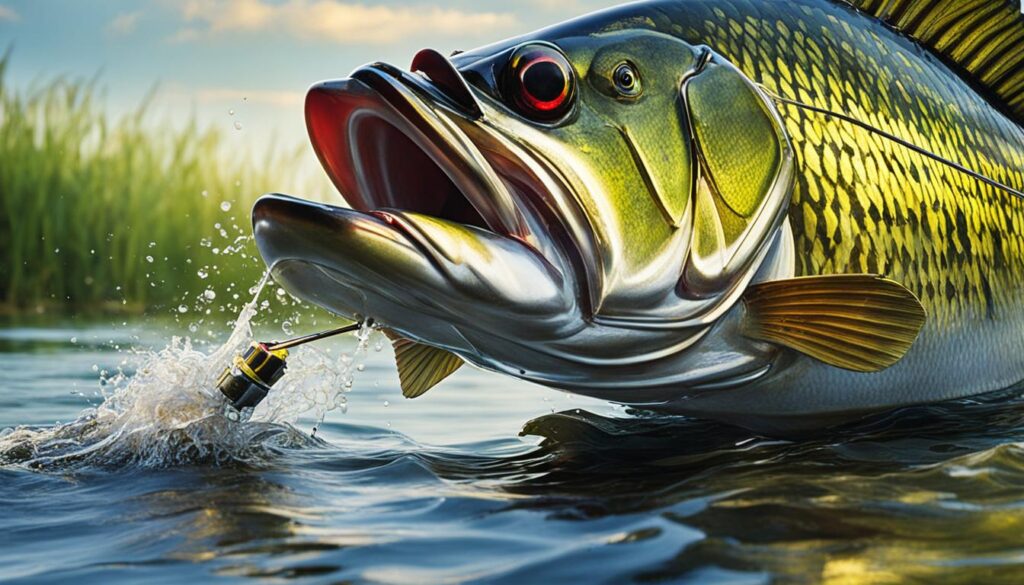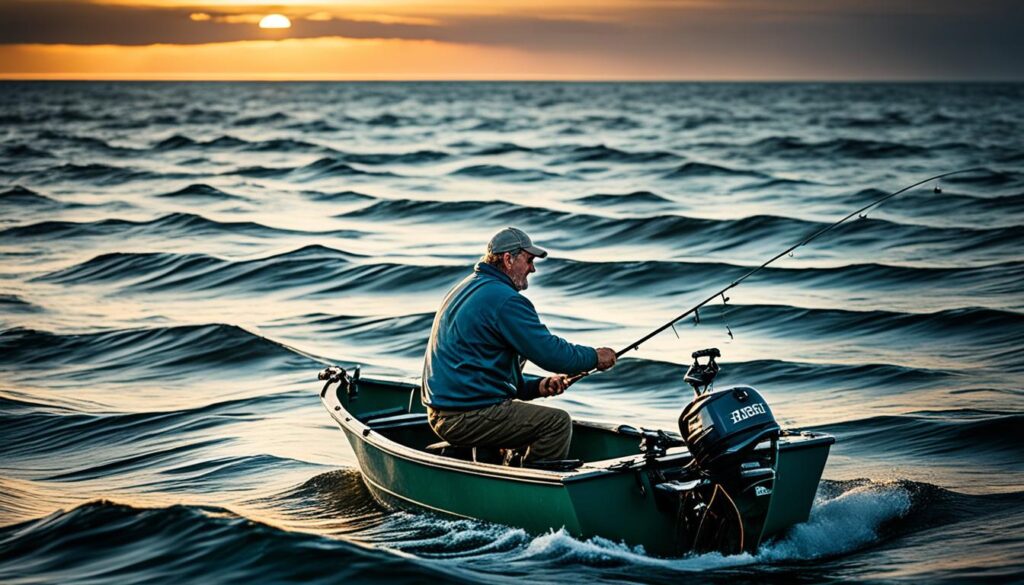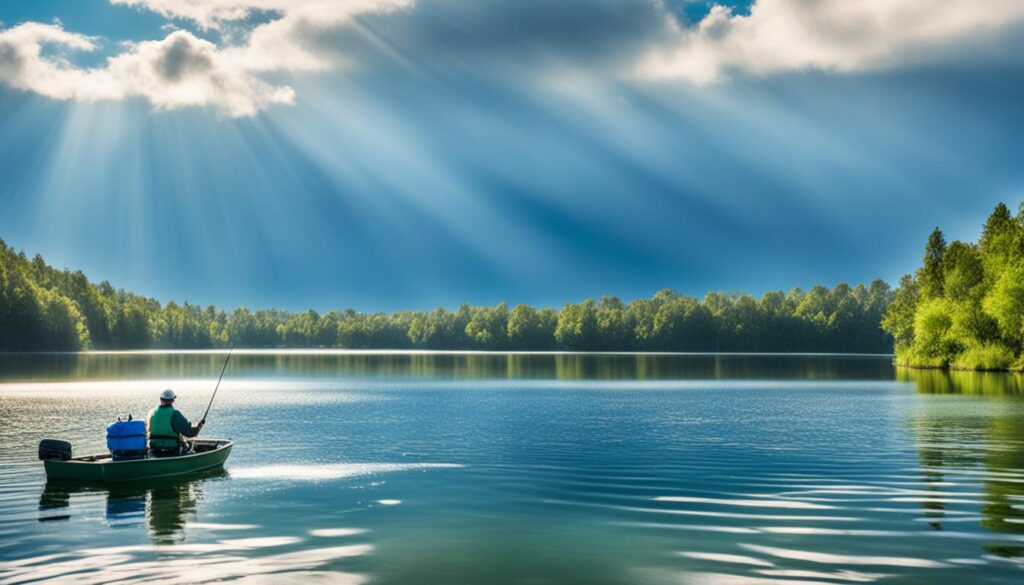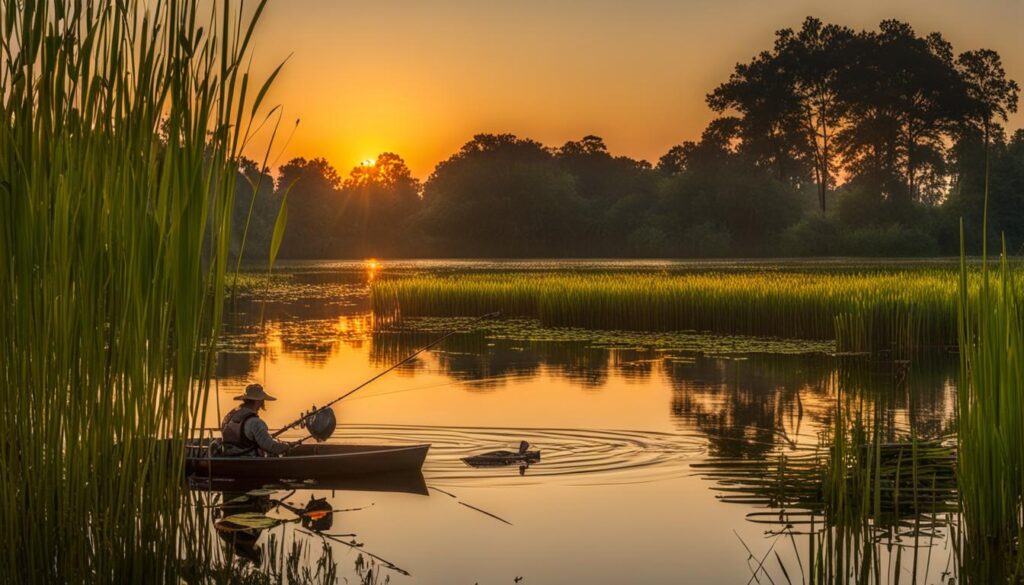Summer bass fishing can be challenging, but you can beat the pressure and catch more fish with the proper techniques. In this article, I will share three awesome summer bass tricks that will help you improve your fishing success. These tips are based on factual data and proven strategies that have been effective for many anglers. So, let’s dive in and discover how you can make the most of your summer bass fishing adventures.
Angler’s essentials
- Downsizing your baits can target fish wary of larger, more aggressive baits.
- Changing your bait angles can make your lure stand out and trigger more bites.
- Seeking out remote fishing locations can lead you to cooler and oxygenated water where bass are more active
- Fishing early in the morning and targeting shallow water can help you avoid hot water temperatures and increase your chances of catching bass.
- Fishing deeper water later in the day can allow you to locate bass in cooler temperatures and find ambush points
Downsize your baits
One effective strategy to beat fishing pressure during the summer is to downsize your baits. Using more diminutive and subtle baits, you can target fish wary of larger, more aggressive lures. This technique takes advantage of fish psychology, as smaller baits can appear less threatening and more natural to the fish.
For example, consider switching to a small single swimbait instead of using a larger crankbait. The swimbait’s smaller profile and more realistic action can significantly attract bites from pressured fish.
Adapting to changing conditions is critical when downsizing baits. Be proactive and switch early to avoid other anglers and capitalize on the new bite before the fish stop biting the larger baits.
Fish Psychology: Why Downsizing Works
“Fish have an instinct to identify and avoid potential threats. When fish encounter larger, more aggressive baits that they’ve seen before, they can become conditioned to associate them with danger. Downsizing your baits offers a fresh approach to trigger their curiosity and increase your chances of getting bites.”
– Expert Angler Interview
Tactical Table: Comparison of Bait Sizes
| Bait Type | Size | Target Species |
|---|---|---|
| Large Crankbait | 3 inches | Largemouth Bass |
| Small Single Swimbait | 1.5 inches | Smallmouth Bass |
| Miniature Jig | 0.5 inches | Spotted Bass |
The tactical table above provides an overview of different bait sizes and their target species. Downsizing your baits allows you to target specific types of bass and adapt to their preferences based on size and behavior.
Change your angles

Changing your bait angles is a clever technique that can significantly increase your fishing productivity, especially when the bite gets tough. You can make your bait stand out among other lures by approaching fish from different directions. This tactic helps draw the attention of fish and entices them to strike. Instead of fishing a hump perpendicularly, try parallel fishing along the drop-off. This will keep your bait in the strike zone for a more extended period and increase your chances of triggering more bites.
Fish can become conditioned to specific baits and presentations, making them less responsive. This is where changing your angles can make all the difference. By presenting your bait from new angles, you’re offering fish a unique and enticing opportunity. Remember, tempting even the most finicky fish only takes a slight adjustment.
Adapting to Fish Conditioning
One crucial factor to consider when changing your angles is the concept of fish conditioning. Fish can become accustomed to certain baits and presentations, associating them with potential danger or avoiding them altogether. By changing your angles, you disrupt their conditioned response and introduce a fresh approach that can trigger their feeding instincts.
Changing my angles has been a game-changer for me. It’s incredible how a simple adjustment in presentation can turn a slow day into a productive one. Fish can quickly become conditioned to specific baits, so I like to switch things up and experiment with different angles to keep them guessing. It makes a difference in getting more bites.
Approaching Fish from Different Directions
When you change your angles, you approach the fish from different directions. This allows you to present your bait in a way that stands out from the crowd. Fish are more likely to strike at a unique or unexpected bait. If you change your angles and offer a fresh perspective, it does increase the chances of enticing a bite.
For example, if you notice a group of bass positioned near a structure, try approaching from different sides and angles. This will give the illusion of multiple prey items moving around, triggering their predatory instincts and increasing your chances of a successful strike.
The Key to Consistent Success
Demonstrating versatility and adaptability in your fishing approach is critical to consistent success. Changing your bait angles allows you to introduce new presentations and increase your chances of enticing bites from even the most skeptical fish. Fish can get conditioned to specific baits and presentations, so keeping them guessing with fresh angles is essential. By mastering this technique, you’ll undoubtedly become a more skilled angler and enjoy fruitful fishing outings.
Go off the grid
Seeking remote fishing locations can be a game-changer when beating fishing pressure during the summer. By venturing to areas other anglers pass up due to distance or difficulty of access, you can find cooler and oxygenated water where bass are more active. Running up creeks and rivers often leads to the most relaxed and oxygenated water, creating optimal feeding conditions for bass.
This approach requires extra effort, but the rewards can be worth it. When you go off the grid and explore untouched fishing spots, you increase your chances of encountering excellent fishing opportunities during this challenging time of the year.
| Benefits of going off the grid: | Precautions to take: |
|---|---|
| * Cooler and oxygenated water promotes bass activity | * Prepare for longer travel distances |
| * Opportunities for abundant fish populations | * Study and plan for access challenges |
| * Reduced fishing pressure | * Pack necessary supplies and safety equipment |
| * Exploration and discovery of hidden gems | * Be aware of changing weather and water conditions |
“Going off the grid allows me to escape the crowds and find remote fishing locations that other anglers overlook. During these adventures, I’ve had some of my most memorable catches. It requires extra effort but rewards with solitude, untouched fish populations, and extraordinary fishing experiences.” – Jeremy Anderson, Experienced Angler.
Get out early and fish the shallows
Getting out early and fishing the shallows during the summer before the water temperatures rise is crucial. Bass are cold-blooded creatures and seek cooler water to regulate their body temperatures. By fishing the shallow areas in the morning, you can avoid the hot water temperatures and increase your chances of catching bass. It’s crucial to beat the sun to your fishing spot and focus on areas that will receive the full force of the early morning sun.
Early morning fishing provides several advantages. Firstly, the water temperatures are at their most excellent point of the day, which can trigger feeding behavior in the bass. Secondly, the calm and quiet atmosphere of the morning offers a prime opportunity to catch bass that are less wary and more responsive to your bait. Thirdly, targeting the shallows allows you to concentrate your efforts in areas that bass inhabit for feeding, providing a higher likelihood of success.
“Fishing early in the morning can be a game-changer. I’ve had some of my best catches during those golden hours of the day.” – Experienced angler.
To make the most of your early morning fishing, consider using lures that mimic the prey bass feed on during this time, such as topwater baits like frogs or buzz baits. These lures create a commotion on the water’s surface, attracting bass lurking in the shallows. You can make your bait near cover, such as submerged vegetation or fallen trees, as bass often seek refuge in these areas.
Benefits of fishing the shallows early in the morning:
- Increased chances of catching bass
- Cooler water temperatures
- Less competition from other anglers
- Potential to target feeding bass
Remember to arrive at your fishing spot well before sunrise, allowing enough time to set up your equipment and prepare for the action. By capitalizing on the early morning bite and targeting the shallows, you can increase your chances of a successful summer bass fishing trip.
Fish deeper water later in the day

As the day progresses and the water temperatures rise, bass will seek deeper water to find cooler temperatures and suitable oxygen levels. Fishing more profound points, drop-offs, and cuts in the lake or pond can increase your chances of catching bass later in the day. These areas provide excellent ambush points for bass to feed on prey. By understanding the movement patterns of bass and locating these deeper structures, you can maximize your summer bass fishing success.
If you find that the bass bite slows down during the midday heat, don’t get discouraged. Instead, you can adapt your fishing strategy to target deeper water where bass seek relief from the heat and find the best conditions for feeding. Here are a few key reasons why fishing deeper water later in the day can be productive:
- Cooler Water Temperatures: Deeper water tends to remain cooler than shallow areas, especially during the hot summer. This is because sunlight penetration is reduced, and the water at greater depths remains more stable. Fishing in these more relaxed pockets increases your chances of finding active bass.
- Locating Ambush Points: Deeper water often features critical structures that bass use as ambush points to target prey. These can include points, drop-offs, ledges, and cuts—bass love positioning themselves near these areas to take advantage of passing baitfish. By understanding the geography of the waterbody you’re fishing, you can pinpoint these ambush points and increase your chances of encountering feeding bass.
- Proximity to Cover: Deeper water is usually near submerged cover, such as underwater vegetation, trees, or rock formations. These structures offer shade, cover, and a food source for bass. By fishing these areas later in the day when bass seek shelter and food, you improve your chances of enticing a strike.
“Fishing deeper water later in the day allows you to tap into the natural behavior of bass during the summer. Understanding their movement patterns and locating key ambush points can improve your chances of catching bass even under challenging conditions.”
Find life and target active areas

To increase your chances of catching bass in the summer, finding areas with signs of life is essential. By observing baitfish activity, targeting areas with signs of life, and finding feeding zones, you can significantly improve your success on the water.
One key indicator of active bass feeding areas is observing baitfish activity. Keep an eye out for minnows or shad schools swimming near the surface. These baitfish attract hungry bass looking for an easy meal. Additionally, wading birds diving for prey can signal the presence of baitfish and potential feeding zones.
Targeting areas with signs of life is crucial. Active areas with abundant life are likely to attract active-feeding bass. Look for places with vegetation, submerged structures, or drop-offs, as these are often prime spots for bass to hunt for prey.
When searching for feeding zones, consider the behavior and movements of bass. Bass tend to follow specific patterns when searching for food. Please look for areas where the wind or current pushes baitfish since these areas will likely focus on feeding bass.
Signs of Life in Bass Fishing
| Signs of Life | Indications |
|---|---|
| Observing Baitfish Activity | Minnows or shad schools swimming near the surface |
| Wading Birds Diving | Predatory birds diving for prey |
| Vegetation and Structure | Areas with vegetation, submerged structure, or drop-offs |
| Wind or Current | Areas where the wind or current is pushing baitfish |
Best lures for summer bass fishing
When it comes to summer bass fishing, selecting the right lures can significantly impact your success. Here are some of the best lures for summer bass fishing:
1. Topwater Lures
Start your day on the water with topwater lures like frogs and walk-the-dog-type baits. These lures create enticing surface commotions that imitate wounded prey, attracting bass in the early morning hours when they are most active. Cast these lures near cover, such as lily pads or fallen logs, and prepare for explosive strikes.
2. Spinnerbaits
As the day progresses and the sun rises, bass tend to move deeper into the water. To target these fish, use spinnerbaits. These versatile lures can be retrieved at varying speeds and depths, making them perfect for fishing deeper water later in the day. Experiment with different blade colors and sizes to find what the bass are actively feeding on.
3. Plastic Worms
Plastic worms are a staple in any bass angler’s tackle box and excel during the summer months. Wacky-rigged or rigged with O-rings, these soft plastic baits can be cast, flipped, or pitched to target pressured bass. Their natural presentation and lifelike action entice bass to bite even in challenging conditions. Try different colors and sizes to match the local forage and trigger more bites.
4. Live Bait
When all else fails, live bait can effectively entice bass to bite. Minnows and nightcrawlers are popular live baits that can be used to target summer bass. Hook them through the lips or thread them onto a hook, and present them near the cover or along the structure. Live bait provides a realistic scent and movement that can be irresistible to bass.
| Lure Type | Best Use |
|---|---|
| Topwater Lures | Early morning fishing |
| Spinnerbaits | Deeper water later in the day |
| Plastic Worms | Targeting pressured bass |
| Live Bait | When all else fails |
Fishing heavy cover for summer bass
Regarding summer bass fishing, targeting heavy cover can be a game-changer. Bass seek shade to cool down and ambush prey, making these areas prime spots for catching bass. Vegetation such as weed mats and lily pads provide a haven for big bass looking to feed while conserving energy. You can increase your chances of trophy-sized bass by fishing heavy cover.
Targeting Shaded Areas
The key to fishing heavy cover successfully is to target shaded areas. Look for areas where the vegetation creates pockets of shade on the water’s surface. These shaded areas serve as hiding spots for bass, allowing them to feel secure while they wait for an easy meal to pass by. By casting your bait into these shaded pockets, you can increase your chances of enticing a strike from a hungry bass.
Using Frogs and Punch Jigs
For effective heavy-cover fishing, choose lures that navigate through dense vegetation effortlessly. Floating frogs and punch jigs are popular choices.
Floating frogs mimic a frog on the water’s surface, ideal for lily pads and weed mats. Cast into shaded areas, let it pause, then gently twitch for a lifelike frog movement, triggering strikes from hidden bass.
Punch jigs, designed for dense vegetation, have a streamlined shape to penetrate thick mats of weeds. They create a compact and enticing bait paired with a soft plastic trailer. Target holes in the cover allow the jig to sink and mimic prey with quick hops to attract strikes from bass waiting in the shadows.
Frogs and punch jigs effectively fish heavy cover, mimicking natural prey and enticing strikes from elusive bass in shaded areas.
| Floating Frogs | Punch Jigs | |
|---|---|---|
| Advantages |
|
|
| Disadvantages |
|
|
Conclusion
Summer bass fishing can be challenging, but you can still have an enjoyable and successful fishing experience with the right tactics. By utilizing a combination of strategies, such as downsizing your baits, changing your angles, and fishing off the grid, you can beat the fishing pressure and increase your chances of catching bass in the summer months.
Early morning fishing in the shallows can prove fruitful, as bass seek cooler water temperatures in these areas. As the day progresses and the water heats up, targeting deeper water where bass can find relief from the heat becomes more effective. Additionally, paying close attention to areas with signs of life, such as active baitfish or diving birds, can lead you to feeding zones where bass are more likely to be.
Choosing the right lures for summer bass fishing is also essential. Topwater lures like frogs and spinnerbaits can be effective in the early morning, while plastic worms and live bait can entice bass that are under pressure. Lastly, please pay attention to the potential of fishing heavy cover because it provides shade and hiding spots for trophy-sized bass.
Remember to stay adaptable and observant on the water. I want to let you know that understanding the behavior of the adjustments will be great, and making the necessary contributions will only contribute to your success. So grab your gear, apply these summer bass fishing tactics, and get ready to beat the pressure and reel in some incredible bass!
FAQ
What are some effective strategies to beat fishing pressure during the summer?
Downsizing your baits, changing your angles, and going off the grid to seek out remote fishing locations.
How can downsizing baits help in summer bass fishing?
Using smaller and more subtle baits can target fish that have become wary of larger, more aggressive baits.
Why is changing bait angles important for summer bass fishing?
Approaching the fish from different angles can make your bait stand out from the other lures that the fish sees and trigger more bites.
How can going off the grid help in summer bass fishing?
Venturing to areas that other anglers are passing up can lead you to cooler and oxygenated water where bass are more active.
Why is it important to fish the shallows early in the morning during the summer?
By fishing the shallow areas in the morning, you can avoid the hot water temperatures and increase your chances of catching bass.
Where should I fish later in the day during the summer?
Bass will seek deeper water to find cooler temperatures, so fishing deeper points, drop-offs, and cuts in the lake or pond can increase your chances of catching bass later in the day.
How can I find areas with signs of life for summer bass fishing?
Look for baitfish activity and wading birds diving for prey. These active areas are likely to attract bass that are actively feeding.
What are some of the best lures for summer bass fishing?
Topwater lures like frogs and walk-the-dog type baits for early morning fishing, spinnerbaits and crankbaits for deeper water later in the day, and plastic worms and live bait for targeting pressured bass.
How can fishing heavy cover benefit summer bass fishing?
Bass seek shade to cool down and ambush prey, making heavy cover areas like weed mats and lily pads prime spots for catching bass.
What are some important tactics for summer bass fishing?
Downsizing baits, changing angles, going off the grid, fishing early in the morning, targeting deeper water later in the day, finding areas with signs of life, using the right lures, and fishing heavy cover can all increase your chances of catching bass during the summer months.
